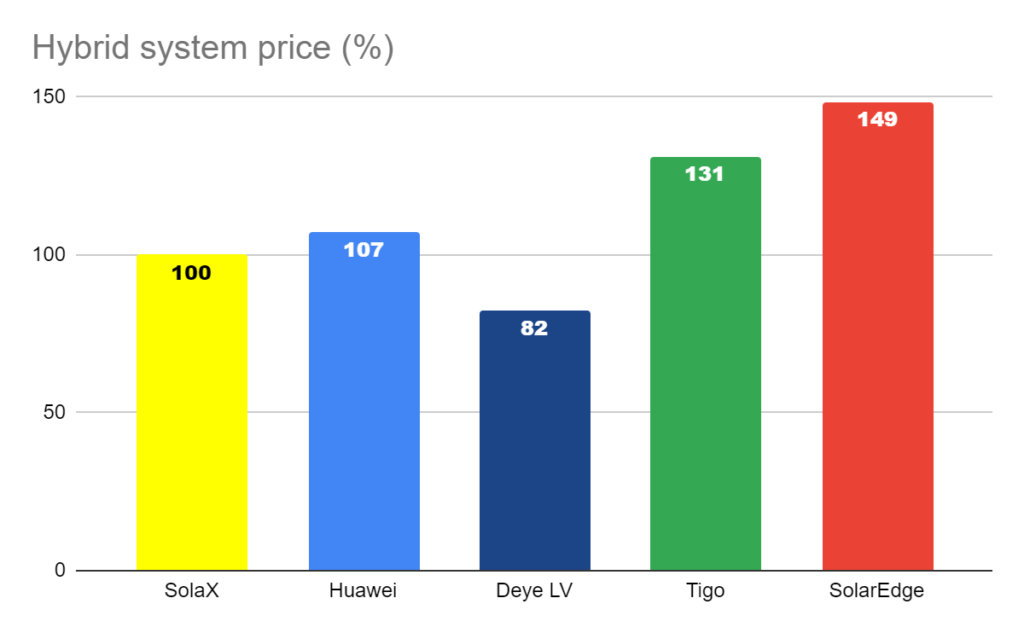A Deep Dive into 5 Top PV Inverter Brands with ESS
In the ever-evolving world of solar energy, the quest for efficient, reliable, and innovative solutions has led to integrating batteries with photovoltaic (PV) inverters. These hybrid systems are revolutionizing how we harness and store solar energy, making it readily available even when the sun goes down. For installers and solar enthusiasts alike, choosing the suitable PV inverter with battery integration can be the key to unlocking the full potential of solar power.
In this comprehensive blog post, we embark on an exciting journey to explore and compare five leading PV inverter brands with battery capabilities: Huawei, Tigo, SolarEdge, SolaX, and Deye. Each of these brands has carved a unique niche in the market, bringing forth its features and innovations designed to cater to the specific needs of solar installers. We’ll delve deep into the technical aspects, discussing the features and benefits that matter most to those at the forefront of solar system installations.
Before we dive into these solutions, let’s address some crucial factors. Different brands offer varying inverter power ranges and battery capacities. To keep things consistent, we’ve focused on inverters with a maximum AC power of around 10 kW and a battery capacity of about 10 kWh.
Some brands, like Huawei, Tigo, and SolarEdge, have their optimizers. So, we’re using their own product when looking at those brands. But we’ve gone with the flexible Tigo TS4 optimizer system for all the other cases. Why? In most European countries, having a rapid shutdown feature is a requirement, which you can achieve with optimizers.
Regardless of the brand, all these systems are similar in terms of what they can do. They’re capable of working in hybrid modes, and they all have a backup function to keep your power flowing smoothly in case of an outage. So, no matter which brand you choose, you’re getting reliable performance.
| Name | SolaX | Huawei | Deye LV | Tigo | SolarEdge |
| Inverter Power (kW) | 10 | 10 | 10 | 10 | 10 |
| Battery capacity (kWh) | 9 | 10 | 12,2 | 9 | 9,2 |
Huawei: Elevating Solar Installation
Pros:
- Plug and Play: Huawei’s PV inverters are renowned for their user-friendly installation process, streamlining the setup for installers.
- Aesthetic Appeal: The design of Huawei’s inverters adds an element of visual sophistication, making them an excellent choice for installations that prioritize aesthetics.
- Outstanding Support: Huawei’s customer support is widely respected in the industry, ensuring that installers have reliable assistance when needed.
- Versatile Product Range: The brand boasts a comprehensive product lineup, offering a diverse range of options to meet various installation requirements.
- Optimization Prowess: Huawei’s integration with its proprietary optimizer technology enhances system performance.
Cons:
- 3-Phase Unbalanced Export Limitation: Huawei’s inverters may have certain limitations when exporting power in 3-phase unbalanced setups, requiring careful consideration.
- Battery Compatibility: Currently, only the LUNA battery is compatible, which may limit choices for battery integration.
Tigo: The Intersection of Style and Function
Pros:
- Sleek Design: Tigo’s inverters feature a modern, elegant design that adds a touch of sophistication to solar installations.
- Market Availability: The widespread availability of Tigo products is advantageous for installers, ensuring accessibility.
- TS4 Integration: Tigo’s integration with the TS4 platform provides module-level control and optimization, enhancing overall system efficiency.
- 3-Phase Unbalanced Mode: Tigo’s support for 3-phase unbalanced setups adds flexibility to installations with such requirements.
Cons:
- Similarity to SolaX: Tigo’s offerings may overlap with those of SolaX, necessitating a careful evaluation of their unique advantages.
SolaX: Versatility and Performance Combined
Pros:
- 3-Phase Unbalanced Mode: SolaX inverters excel in 3-phase unbalanced setups, offering versatility in complex installations.
- Diverse Product Range: SolaX provides various product options to cater to diverse project requirements.
- Battery Compatibility: The brand offers flexibility with various battery compatibility options, tailoring systems to specific needs.
Cons:
- Customer Support: SolaX has been noted for less-than-optimal customer support, potentially causing challenges for installers.
- Common Technical Issues: Some users have reported technical issues with SolaX inverters, necessitating proactive troubleshooting.
- Availability Concerns: The availability of SolaX products may raise concerns, potentially impacting project timelines.
SolarEdge: Precision and Innovation
Pros:
- Optimization Excellence: SolarEdge is acclaimed for its top-notch optimizer technology, maximizing energy harvesting potential.
- Smart Home Integration: Integration with smart home systems enhances system control and monitoring, elevating the homeowner’s experience.
- Aesthetic Appeal: SolarEdge’s inverters feature a sleek design, adding an attractive element to solar installations.
- Outstanding Support: SolarEdge’s customer support is highly regarded for its responsiveness and valuable assistance.
Cons:
- 3-Phase Unbalanced Export Limitation: SolarEdge’s inverters may have limitations when exporting power in 3-phase unbalanced setups, requiring careful consideration.
- Availability Challenges: The availability of SolarEdge products may pose challenges, necessitating advanced planning for installations.
Deye: Innovation for Practical Solutions
Pros:
- Integrated Battery Management: Deye’s inverters feature an integrated Battery Management System (BMS), simplifying battery integration and management.
- Enhanced Reliability: The integrated backup feature ensures system reliability during power outages, a critical factor for homeowners.
- Customization Options: Deye provides a wide range of setting options, allowing for customized solutions tailored to specific needs.
- Asymmetric limitation: Deye inverters excel in 3-phase unbalanced setups, offering versatility.
Cons:
- Customer Support: Deye’s customer support has been reported to need more responsiveness and assistance, potentially posing challenges for installers.
- Documentation Shortcomings: Comprehensive documentation may be limited, requiring installers to navigate technical challenges independently.
- Sharing Design Aspect: Deye’s sharing design may only be suitable for some installation scenarios.
In conclusion, the choice of PV inverter brand with battery integration is a critical decision for installers. Each of the brands we’ve explored—Huawei, Tigo, SolaX, SolarEdge, and Deye—brings its own unique blend of technology, features, and benefits to the table. Your selection should align with the specific requirements of your projects, considering factors like efficiency, compatibility, support, and budget. With the right choice, you can unlock the full potential of solar energy and deliver efficient and reliable solutions to your clients, furthering the transition to a sustainable future.
| Name | SolaX | Huawei | Deye LV | Tigo | SolarEdge |
| Inverter | X3-HYBRID-10.0 G4.3 WIFI + CT | SUN2000-10KTL-M1 | SUN-10K-SG04LP3-EU | TSI-10K3D | SE10k – 3phase – Home Hub |
| Backup Box | X3-EPS BOX | Backup Box B1 | – | EI Link | Backup Interface |
| BMS | BMS FOR T30 BATTERY | POWER MODULE LUNA2000-5KW-C0 | – | EI BMS | – |
| Battery | 3 x T30 3KWH | 2 x BATTERY MODULE LUNA2000-5-E0 | 2 x Deye RW-M6.1 (6,1kW) | 3x EI Battery | 2 x HOME BATTERY |
| Smart meter | – | THREE PHASE METER DTSU666-HW | – | – | SOLAREDGE INLINE ENERGY METER |
| Accessories | Power Cable 1,8M for T30 | – | Pylontech cable kit for inverter | EI Battery Accessories | Cabels |
| Accessories | T30 accesory pack | – | – | – | Top cover and floor stand |
| Optimizer Accessories | TAP | – | TAP | – | – |
| Optimizer Accessories | CCA | – | CCA | – | – |
| Optimizer x 22 | Tigo TS4-A-O 700W | SUN2000-450W-P | Tigo TS4-A-O 700W | Tigo TS4-A-O 700W | S440 |
When embarking on the journey to harness the potential of solar energy, there’s a crucial factor that demands attention: system price. In the realm of photovoltaic (PV) inverters with integrated batteries, where technology and innovation intersect, the cost of your chosen system can have a profound impact on the feasibility and appeal of solar projects. Striking the right balance between advanced features and affordability is a central challenge that resonates with both installers and homeowners.
In this comprehensive analysis, we’ll delve into the system prices of five prominent PV inverter brands: SolaX, Huawei, Deye, Tigo, and SolarEdge. To provide a clear perspective on their cost-effectiveness, we’ll express these prices as ratios relative to SolaX’s system price (set as 100%). This approach allows us to gain a nuanced understanding of how these brands compare in terms of value and pricing.
Comparative Analysis of System Prices
SolaX (100%): As our reference point with a system price set at 100%, SolaX serves as the baseline against which we gauge the other brands.
Huawei (107%): Huawei’s system price is approximately 7% higher than SolaX’s. This modest premium reflects Huawei’s commitment to advanced technology and user-friendly design while remaining competitively priced.
Deye LV (82%): Deye LV presents a system price that is about 18% lower than SolaX’s, positioning it as a cost-effective choice in this comparison.
Tigo (131%): Tigo stands out with a system price approximately 31% higher than SolaX’s. This suggests that Tigo positions itself as a premium choice with a corresponding increase in cost.
SolarEdge (149%): SolarEdge’s system price is approximately 49% higher than SolaX’s. This underscores the premium associated with SolarEdge’s advanced optimizer technology and integration features while still maintaining a competitive edge in pricing compared to other brands.
This comparative analysis underscores the paramount importance of cost-effectiveness in solar energy solutions. Brands such as Deye and SolaX provide competitive options at a more accessible price point, while Tigo and SolarEdge position themselves as premium alternatives, offering advanced capabilities, albeit at a higher cost. As you embark on your solar journey, meticulously assessing your budget and project requirements will be instrumental in making an informed decision that maximizes the value and performance of your solar energy system.

For a comprehensive exploration of compensation details, we encourage you to delve into our earlier article, where we conducted an in-depth comparison between Huawei’s ESS solution and Deye’s ESS solution. In that extensive analysis, we meticulously examined various aspects of these energy storage systems, shedding light on compensation-related matters. If you need any technical assistance or guidance, do not hesitate to contact our dedicated technical support team at pv-support@solarity.eu. Whether you’re working with Deye or Huawei’s ESS system, we provide the help and support you need to make the most of your chosen solution. Feel free to contact us anytime; we’re ready to assist you in achieving the best possible results with your ESS system.
Author: Dániel Kovács, Technical Support
Posts you might like:

Subscribe to our newsletter
so that you don’t miss any news!









